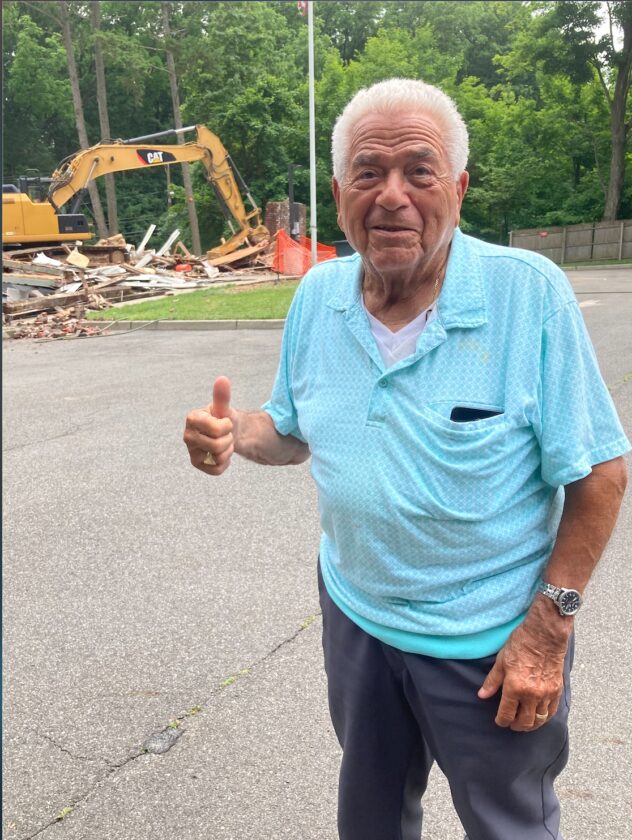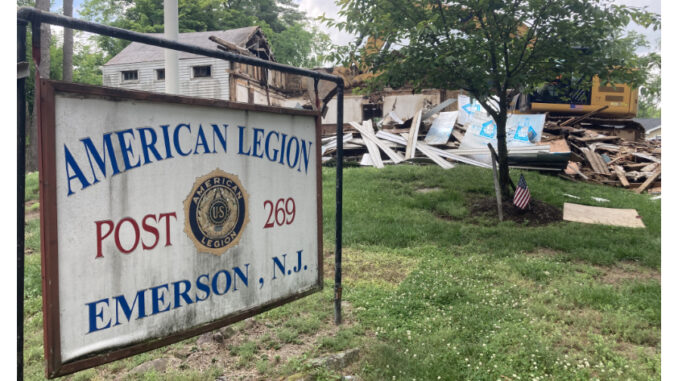
EMERSON—One of the borough’s oldest buildings — the DeBaun House, built in the 1770s — is down, reduced to rubble in a day’s work.
The scene at the former American Legion Post 269 drew a handful of onlookers, including a River Vale resident, Dennis Ruby, who claimed a floorboard for a home project; a member of the borough’s Historic Preservation Commission, who braved the wreckage to point out the original foundation and signs of old fire damage; and a Legionnaire, who gave the thumbs up as the last pieces standing collapsed.
Borough officials have said that in the building’s place, the legion post, which owns the building on its 1.6 acres, aims to construct four one-bedroom apartments for veterans. The post and other stakeholders already built an adjacent 14 affordable apartment units for veterans. Whatever rises here also will accommodate a Legion space.
Borough and post officials said many efforts to preserve the Dutch-style building were attempted over the last several years but structural issues, mold, and widespread second-floor damage caused by a plumbing leak, and dry rot found on the exterior had made restoration too difficult.
The house served as a meeting site for veterans since after World War I, in addition to a community resource that has hosted community and social events, for adults and youngsters alike.
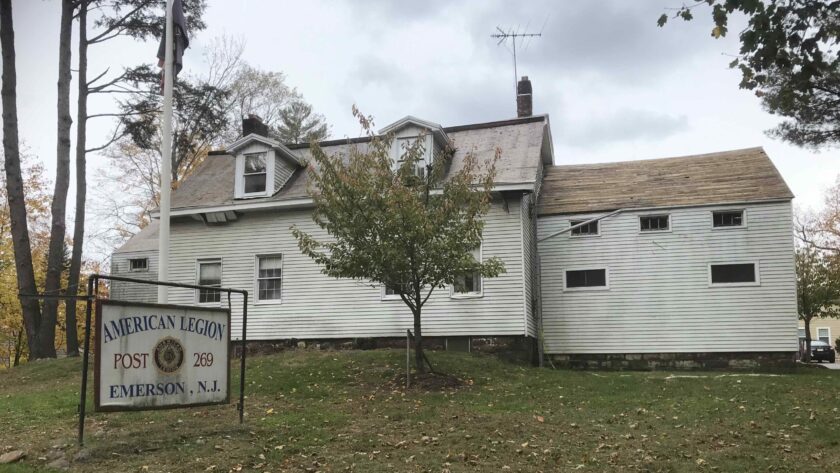
The building was not eligible for state or federal historic listing due to its extensive alterations.
Mayor Danielle DiPaola shared the sad news at the Oct. 19, 2021 meeting of the governing body: the DeBaun House was scheduled to be knocked down within weeks. (See “Time’s up for DeBaun House: Home served American Legion, generations of Emersonians,” Pascack Press, Nov. 6, 2021.)
She called it “very unfortunate” and invited comment from then-Council President Kenneth Hoffman and Councilwoman Jill McGuire, both of whom were involved in preservation efforts.
Hoffman said the building, one of Emerson’s two oldest, dates to the original settlement of the area. He said the DeBauns “were one of the founding families of this area before it actually became Emerson.”
Hoffman said plans were for the county to preserve the structure. “So it’s disappointing to me and it’s disappointing that they didn’t follow through with that intention. It is a loss for the town.”
He said it was also a loss in terms of relics of the old Jersey Dutch community known as Old Hook and that the only such building left after DeBaun is gone will be the Old Hook Farm structure. “So it’s with sadness I see this happening.” (The borough’s “The Peter DeBaun House: A History” explains, “The name itself derives from the Dutch word hoek, meaning ‘angle’ or ‘corner,’ and refers to the corner of land circumscribed by three connecting waterways: the Musquapsink Brook, the Pascack Brook and the Hackensack River.”)
In an email to Pascack Press, Hoffman said at the time the structure should have been saved.
“I believe that the home could have been restored and preserved by the Housing Authority of Bergen County (HABC), which was their original intention when the application was approved for the veterans housing some years ago. The architectural firm that did the report for HABC said that the building could be restored for use by the Legion, despite the HABC’s public statements to the contrary; the building isn’t beyond repair and the foundation isn’t crumbling,” Hoffman said.
He added, “Based on a conversation I had with a construction expert, the estimate for restoration was overestimated, and I believe funding could have been acquired to save it. This is a great loss for the history of our town and the surrounding area, since such historic buildings are irreplaceable. Its demolition will be a sad day for Emerson.”
Witnesses at the end
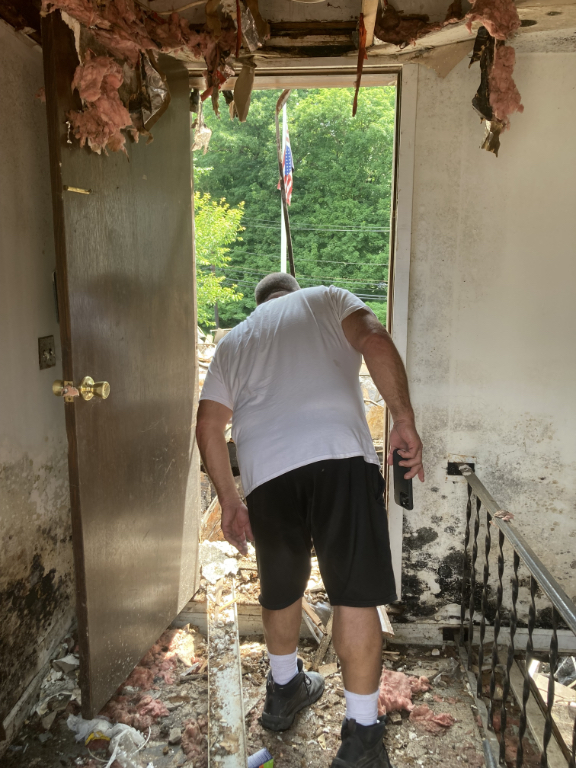
On June 13, 2022, there was no fanfare for the site, as a lone dozer went to work, its pincers biting off substantial but well reasoned mouthfuls. The day was damp, with rain threatening.
Ruby, from River Vale, said he was sad the building, across from Emerson Woods Preserve, was coming down. “It’s history. It’s American history. I’ve got two granddaughters [ages 7 and 11] and they don’t get this stuff in school. They don’t really teach American history.”
The Legionnaire, who’d served in the U.S. Army in Germany in the 1950s, said he looked forward to the new meeting space. “This was what we wanted. It couldn’t be saved,” he said.
Phil Mazzo, chair of the Historic Preservation Commission, and a firefighter, pulled up in a white truck and took advantage of a lunchtime lull in the demolition — the two workers standing at the edge of the muck and eating their lunch out of clear plastic containers — to poke around in the oldest part of the former building. He took photos and pointed out charred beams from a fire long ago. “All the beams in the basement have fire damage,” he said.
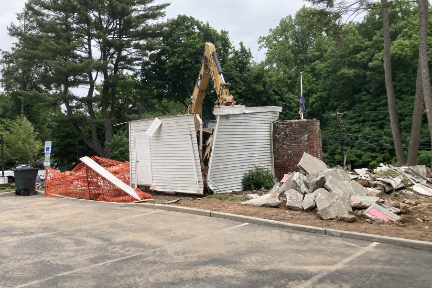
“It’s all rock, stone in the basement foundation, all cemented over,” he said. Approaching the oldest part of the building, he called out the difference in the foundation from its original site to when the building was expanded.
“Back in the day they had the water main right through the middle of the building. Why it didn’t freeze several times through the winters I don’t know. But it never did,” he said.
He disappeared down the bulkhead steps, amid glass shards, moldy drywall, twisted wreckage, and the imminent final bites of the dozer, and called up his report about the stone at the foundation of the DeBaun House. “This is it! This is what they built it on.” He called up more signs of old fire damage and admired the hand-placed stonework.
Then he got out of the way as, lunch done, the demolition roared back to life.
